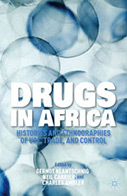Drugs in Africa: Histories and Ethnographies of Use, Trade, and Control

Editors: Gernot Klantschnig, Neil Carrier, and Charles Ambler
Publisher: New York: Palgrave Macmillan, 2014. 220p.
Reviewer: Simon Howell | September 2015
Contemporary analyses of the production, distribution, use, and users of illegal substances in Africa frequently draw on specific presuppositions, many of which are rooted in or underpinned by the historical project of colonialism. For instance, Africa – and Africans – are often defined as ontologically inferior, slow-witted, and uniform. Drug scares in Africa (or about Africans), as in many other parts of the world, furthermore serve to magnify and embed these assumptions as core ‘truths,’ the resulting discourses of which serve to justify acts of exclusion and domination. Such acts, and the violence often accompanying them, frequently shaped the ‘war on drugs.’ Importantly, they also distort more nuanced understandings of the role that drugs have played (and continue to play) in a number of African societies and, while often implicit, cement understandings of a ‘dark’ continent inhabited by a homogenous and ‘undeveloped’ population. Such perceptions have been critiqued from a variety of perspectives, yet research at large concerning drug-related issues on the continent seems to be immune to these critical reflections — continuing to implicitly rely on the tired and hackneyed assumptions that are seen to define ‘the African.’
Drugs in Africa: Histories and Ethnographies of Use, Trade, and Control (2014) explicitly sets out to challenge these assumptions, and does so admirably by bringing together a number of intriguing essays from a range of authors writing from very different perspectives. The result is an account of the drug trade in Africa, and African drug use and users, that is nuanced, critical, and in direct contrast to the many ‘reports’ and ‘dossiers’ that continue to paint an alarmist, simplistic, and (ironically) ineffectual picture of the complexities of this economy. As the editors point out, the fear-mongering focus on the use of drugs in contemporary Africa began when a number of international agencies reported on the expansion of the transnational trade of cocaine into West Africa, the ‘narco-state’ of Guinea-Bissau often serving as a paradigmatic example. To presuppose that drugs suddenly ‘exploded’ on the continent, and that African countries and citizens are defenceless and weak against these ‘onslaughts’ is not only historically incorrect, it is thoroughly Eurocentric. Both historically and contemporaneously, Africa plays host to a diverse population of people who use drugs in a diverse manner of ways, and for a diverse number of reasons. Just like most of the rest of the world.
Whether it is alcohol, cannabis, khat, or heroin, the authors collectively show that drugs have played many roles, often have long and complex histories, and are not simply consumed by an unwitting population. Indeed, one might draw on comparisons between colloquial inferences that often define both the concepts of ‘addict’ and ‘African’ – both are often implicitly defined as being at the whim of their physical desires and slavish dupes of their own bodies. These inferences stand in contrast to the intentional rationality of those who can control those desires, and as such (as displayed by the missionary zeal of many colonialists), feel it their ‘duty’ to ‘discipline’ those who are assumed to be ‘weaker.’ Drawing on a variety of sources – historical records, contemporary literature, and medical statistics for instance – the editors have compiled an illuminating, yet succinct critique of these discourses and assumptions. The result is a book that does not simply speak to issues concerning drugs, but to the much deeper concern with how both Africa and its many populations continue to be defined.
Indeed, it is this synthesis that is perhaps the most appealing and important aspect of this compilation. As a number of the chapters point out, there remains a continuing lack of conversation amongst those working on the topic of drugs in Africa. Drawing on the South African example, for instance, there remains an almost complete lack of interdisciplinary work concerning drug-related phenomena in the country that draws on both the public health and criminological literature. Considering that drugs have serious public health implications, especially in the context of very high levels of inequality, poverty, and criminal activity, and that these are primarily dealt with through the police or the criminal justice system, this is extremely surprising. When these conversations do occur, as pointed out by a number of these authors, they can often be stunted by a lack of common language. Unfortunately, and continuing with the South African example, this lack of integration is replicated in the regulatory environments intended to engage with the drug economy. Here, police remain the primary port of call (however ineffective), and those institutions tasked with engaging with the public health concerns of drug use are frequently unable or unwilling to apply themselves to the issues in a concerted manner. That this book’s authors have focussed on a number of important common concerns, and found a common language, demonstrates that such discussions are not only possible, but that they are themselves extremely important and illuminating. In light of many African societies’ contemporary heterogeneity and complexity, accurate analysis really does require a broader conversation. Additionally, but unfortunately still all too common, such conversations between the disciplines should not be stunted by pithy concerns with the politics of the epistemological prioritisation of ‘scientific’ understandings of drug use at the expense of nuanced and experiential information, or vice versa.
Speaking to the chapters specifically, Charles Ambler’s overview provides a useful contemporary illustration of the role that Africa and African countries play in the transnational trade in illegal drugs. Frequently drawing on the example of alcohol, he shows how regulations in South Africa developed in conjunction with those elsewhere, such as the passing of the 1906 Pure Food and Drugs Act and the 1914 Harrison Act in the US. Even though these societies are vastly different, they have not been subject to manipulation, ineffective regulation, and numerous public health concerns. The second chapter teases out the historical interplay between consumption, alcoholic beverages, and social identity in West Africa – the result is a nuanced, albeit brief critique of consumer patterns, the alcohol industry, and cultural capital in a number of West African countries. Further drawing on an expansive body of work, Klantschnig’s chapter on cannabis speaks directly to the concerns mentioned above, showing how cannabis use has played an integral role in the development of modernity in Nigeria. The fourth chapter focuses specifically on alcohol in Kenya while further building on this theme, showing how alcohol-related consumption patterns played a pivotal role in defining ‘the modern.’ Neil Carrier’s work on khat is paradigmatic, and his chapter further develops his considerable body of work on the substance – focussing on its role as a social, cultural, and anthropological ‘lubricant’ in Kenya. Considering that khat’s legal status remains contested, it is an especially interesting contemporary example, and is usefully teased out through the socio-legal lens that Carrier employs. Another extremely important chapter on a little researched topic is Donna Patterson’s work on ‘The Illegal Trade in Pharmaceuticals.’ As has been reported at the global level, the illicit use of pharmaceuticals is a continuing and pertinent problem. Having a history of the trade of such chemicals in Africa is especially useful for contemporary analyses. Indeed, the penultimate chapter focuses on heroin use in Tanzania, a subject matter that has barely been touched upon in the broader body of literature, and one that will be of relevance to academics and practitioners alike, whether in public health, politics, or criminology. Finally, Ann Laudati provides a socio-economic analysis of cannabis trading patterns in Eastern Africa, showing how these networks are anything but simple or homogenous, and are in fact a reflection of a diverse, contested, and complex society.
If one were to level criticism at this book, it would be that it is far too short. Of course, such limitations are often imposed, but to truly represent the diversity of drugs, their use, and problems in Africa requires a far more expansive engagement. While the editors do indeed acknowledge that this is a limitation, the book begs for the inclusion of further examples and chapters. This is, of course, not perhaps a critique but an indicator of the originality of the analyses contained therein. Ironically, such overviews are often provided by international agencies, yet fail to draw on anything more than self-reported data from host countries. Again, it seems that a lack of conversation is stunting research, with the epistemic prioritisation of quantitative data (even if self-reported) receiving pride of place, with far less effort expended on understanding why these substances remain important.
Minimally, Drugs in Africa shows that a dialogue with a diverse range of voices is not only illuminating and constructive, but necessary in the development of more effective regulatory programmes and protocols. As has now been widely noted, the ‘war on drugs’ – whether in Northern America or Africa – remains a dismal failure. The legacy of this war continues, however, not only in the knowledge that is produced regarding drugs in Africa, but also in the many works that continue to privilege epistemological understandings of what and who constitutes an imagined Africa that bears scant resemblance to the continent, both contemporarily and historically. Drugs in Africa is then not only important, but timely. Simply rehashing old debates, calling them ‘new paradigms,’ and giving them new logos is ineffective, and continues the very logic by which the ‘war on drugs’ was founded and defined through the discourses of racism, moral panic, and sexism. Fortunately, Drugs in Africa provides a relevant critique of this, and as such is a unique and worthy read.
Dr. Simon Howell is Postdoctoral Research Fellow in the Centre of Criminology at the University of Cape Town, South Africa.


